Product Hub September 30, 2015
More than a Dream
Shops around the country are doing things with their equipment and facilities that would be the envy of their brethren. Here are eight examples of how these screen-printing shops differentiate themselves.
Case Study
Shops around the country are doing things with their equipment and facilities that would be the envy of their brethren. Here are eight examples of how these screen-printing shops differentiate themselves.
Dream Up A …
High-Tech Equipment Upgrade
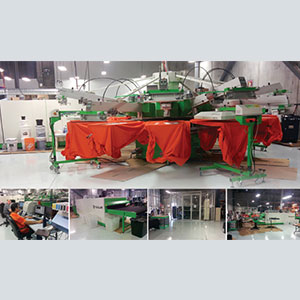
FIEL (asi/53509) was started 25 years ago, but despite its success, the Canadian supplier felt compelled to add in-house decoration at the beginning of this year to grow its American business. “In the U.S., in order to really succeed, you need to be a one-stop shop,” says Asif Bandeali, the company’s VP of sales and technology. With an established business, the supplier didn’t want to settle for a budget solution. Bandeali and FIEL spent the better part of 2014 researching its options before investing in an auto and manual press and a gas tunnel dryer (all from ROQ) in addition to an automatic screen coater and a computer-to-screen imaging system. Says Bandeali: “We’re a company that strongly believes in technology … so we wanted to start off with the best of the best from day one and minimize the manpower needed to run an efficient screen-printing shop.” The supplier hired an experienced production manager, but also used several long-time employees who had no knowledge of decoration, but were able to learn quickly given the equipment’s technology and ease. Currently, a quarter of client purchases utilize the company’s in-house screen-printing, and the supplier isn’t stopping there; Fiel has also added heat transfer in the last month and will add embroidery by the end of this year.
Dream Up A ...
Fool-Proof Floor Plan
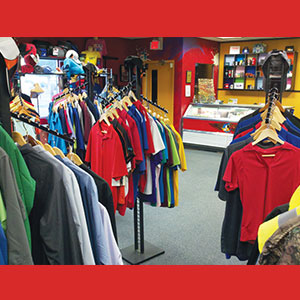
Shirt Lizard (asi/700524) previously occupied a 6,000-square-foot facility with two presses and embroidery machines. “We were all on top of each other, and the workflow was horrible,” says Owner Toby Peltier. “We were at work until 8, 9 o’clock sometimes because it was very difficult to move product in and out.” Not so in the Charlotte decorator’s current location, a 16,000-square-foot facility it moved into in 2012. The central feature is a 10,000-square-foot warehouse that has no columns or support beams. “It just makes it so much easier to arrange our equipment exactly where we want it,” Peltier says. Working with M&R, Peltier considered six to eight floor plans before finding the right layout, a modest semi-circle that houses the contract printer’s four autos, one manual and two dryers. The presses are far enough from the back wall to avoid the ink and screens (the “dirty” side of the shop), allowing Shirt Lizard to keep a cleaner production floor and easily stage the jobs for the day. “Even with the same equipment, just the efficiency alone increased 20-30%,” says Peltier. Plus, the decorator had space to double its equipment, which allowed Shirt Lizard’s workforce to go home at a reasonable time.
Dream Up A …
Snazzy Showroom
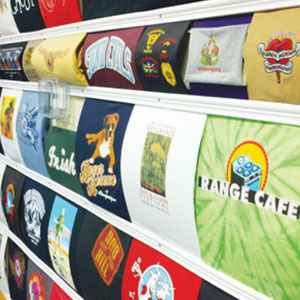
Black Duck Embroidery and Screen Printing’s brand identity is punctuated by the BAM! and POW! of a retro comic book theme, and the decorator carries that over into its lively showroom. The mid-century aesthetic is peppered with unique features like an old gas pump fitted with a video display and a Black Duck emblazoned retro deli case stocked with promos. The Albuquerque, NM, decorator has categorized display areas geared to certain markets (workwear, sportswear, school and athletic wear, and apparel for medical professionals). On the back wall is a rotating collection of the company’s best prints that also “are specifically chosen to help explain printing processes, specialty materials and other options to our prospective customers,” says Erich Campbell, the company’s e-commerce manager. Additional touches include a dedicated conference room with Black Duck murals splashed on the wall and a central atrium accented with handpainted hot air balloons (a local pastime) and distressed wood signage. “Black Duck provides an attractive, comfortable and creative space,” Campbell says, “that allows our customers hands-on time with our apparel and accessories as well as space for interactions of every scale with our sales and design staffers. Clean space, informative displays and consistent branding make our showroom one of the best in the business.”
Dream Up A …
Show-Stopping Workplace
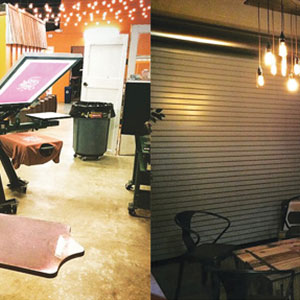
Hey Monkey! Design + Print is the fruit of a life reinvention for do-it-all founder Lenny Terenzi. A former graphic and digital Web designer, the Durham, NC, resident spent 15 years cooped up in his home office before deciding his work should be devoted to making something tangible. “If I have a day of printing,” he says, “the chance to get up and be up on my feet and doing stuff for six, seven hours, and actually hurt a little bit when I go home – kinda nice!” Three years ago, with no knowledge of the craft, he learned how to screen print and opened a boutique creative design company to brand and “print others’ cool stuff.” The one-man company’s signature feature is its lived-in studio, which features design flourishes like reclaimed wood, Edison lights, exposed ductwork, theater seats and much more. The 1,750-square-foot warehouse space was a featureless white brick and concrete box before Terenzi sketched out his vision, and a crew of 30 friends and family helped him transform it. Now, Terenzi holds workshops and events for others to learn about screen printing, or simply opens his doors as a gathering place for other creatives. “If I’ve got to go somewhere to work and have a commute again after 15 years, I want to walk into an inspiring space,” he says. “A place that makes me inspired to create. And I want other people to walk in and go ‘Holy s***, this is amazing.’”
Dream Up A …
Place to Own
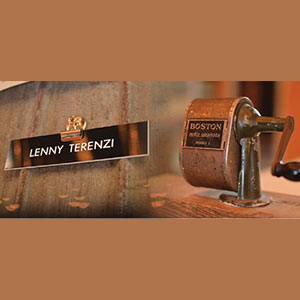
Relik Apparel was growing and its needs were changing. The Naples, FL-based screen printer was ready to add an automatic press, but something was standing in its way. “In our case, we just didn’t have the room,” says President Dany Ochoa, “but we knew where we were heading [as a business].” The company’s 1,200- square-foot space was too small, so when it came time to find its next space, Ochoa decided to build something from the ground up. After purchasing a parcel of land, it took about a year to plan and have contractors build Relik’s new facility, with 3,000 square feet of space. By doing so, Ochoa was able to tailor the plans specifically for his operation, such as ample power (400 amps) and carving out enough space for additional equipment.
“It’s just like in your personal life, where you rent a place or decide to buy your own.”
Dany Ochoa, Relik Apparel
Since moving in this January, Relik has tripled its production with a new ROQ automatic press it purchased, and has room to add additional equipment (such as another auto) in the future. Ochoa says building a facility is not the ideal solution for everyone (land costs can seriously strain a budget), but it made sense for Relik’s long-term growth. “It’s just like in your personal life, where you rent a place or decide to buy your own,” he says. “You’re going to be paying rent for somebody else or paying a mortgage for something that will eventually be yours.”
Dream Up A …
DIY Solution
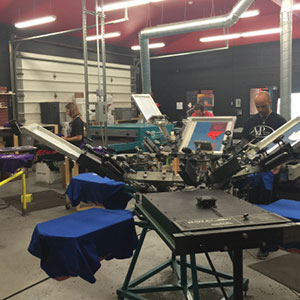
T Productions Owner Tony Kozlowski believes there is no screen printing without screens – a motto the Mishawaka, IN-based decorator proudly exhibits in its custom-built equipment. “In relying on screens as a bridge between artwork and printing, large-scale shops will need some special equipment to house and dry screens on a large level,” Kozlowski says. Take the company’s custom designed and built dry cabinets. Each features an industrial dehumidifier and air handler, and uses a sliding rail system that advances the screen in front of it. For reclaiming, once 25 screens are inserted, they exit the cabinet into the darkroom totally dry, where they are automatically coated and inserted into a different cabinet. The same technique is used after the screens are developed, and all screens dry in the proper orientation – horizontal and stencil side down, which eliminates water streaks, runs and other mishaps. “By adding these types of drying cabinets,” Kozlowski says, “you can reduce your movement, increase productivity and, most importantly, increase screen quality.” The decorator has extended its custom touch elsewhere by outfitting a typical shirt cart with a 25-slot screen rack. As a result, screens effortlessly move from press to press, and “our screen casualty has also gone way down due to screens not being stacked under the cart, or being carried two or three in each hand by a person,” Kozlowski says. In the future, each cart will have its own iPad with the job pulled up in its system.
Dream Up A …
Path to Growth
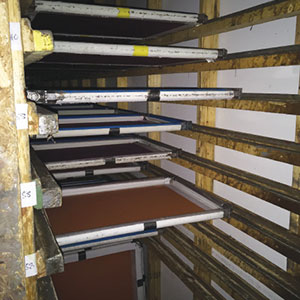
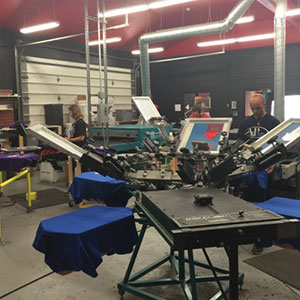
A&P Master Images (asi/702505) Owner Howard Potter set a goal of increasing his screen-printing business by $300,000 this year. Additional equipment was necessary, but it had to fit within a 1,200-square-foot space the Utica, NY, decorator allocated for screen printing (part of a new location it moved into in 2014). “We always try to buy our equipment as compact as possible within reason to maximize what we can produce per square foot,” Potter says.
Finally having space for an automatic press, A&P purchased the Workhorse Sabre with a 16x16 footprint. The company outfitted its dryer with an extension to increase production while maintaining belt speed. A second exposure unit streamlined production. A converted plywood box became a second drying cabinet (one to hold cleaned screens, the other emulsified screens) to avoid cross-contamination. Lastly, the decorator purchased a second washout booth to dedicate one to cleaning and the other to spraying out screens. “Before,” says Potter, “we would have to stop cleaning screens so the person could use the washout booth to spray out their screens that they just shot. Sometimes the screen would get ruined because the person that was cleaning screens didn’t clean the booth out the night before, and you got backsplash over it.” Potter says A&P is not even close to maxing out its production as it tries to grow its overall business by half a million dollars next year: “We have more than enough equipment to accommodate that.”
Dream Up A …
Retail Presence
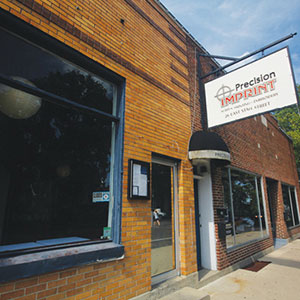
Precision Imprint is an anomaly when it comes to its location. “It’s an industrial-type building in a downtown area,” says Owner Randy Shoup. It’s an asset for the Athens, OH, decorator, which is one street away from Ohio University and all of its fraternities, sororities and groups. Since 1983, Precision Imprint has occupied a 6,000-square-foot building with a sizable basement that houses all of the decorator’s equipment and production. Meanwhile, on the top floor, Shoup has operated a retail store that peddles the company’s custom-printed tees. The store has a local bent, with dozens of apparel items and accessories featuring Athens prints, university gear and other items that attract tourists and locals. “We have more street presence,” says Shoup, who has run the business since 1978. “It’s like good advertising to have a storefront. … Now people can see where we are.”
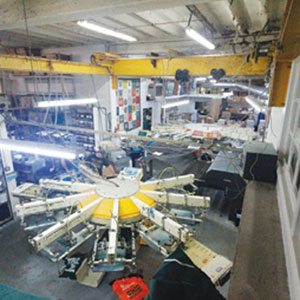
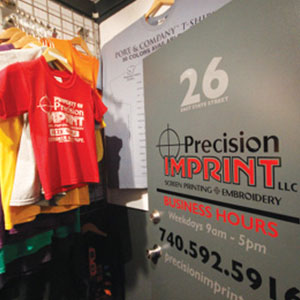

Product Hub
Find the latest in quality products, must-know trends and fresh ideas for upcoming end-buyer campaigns.
